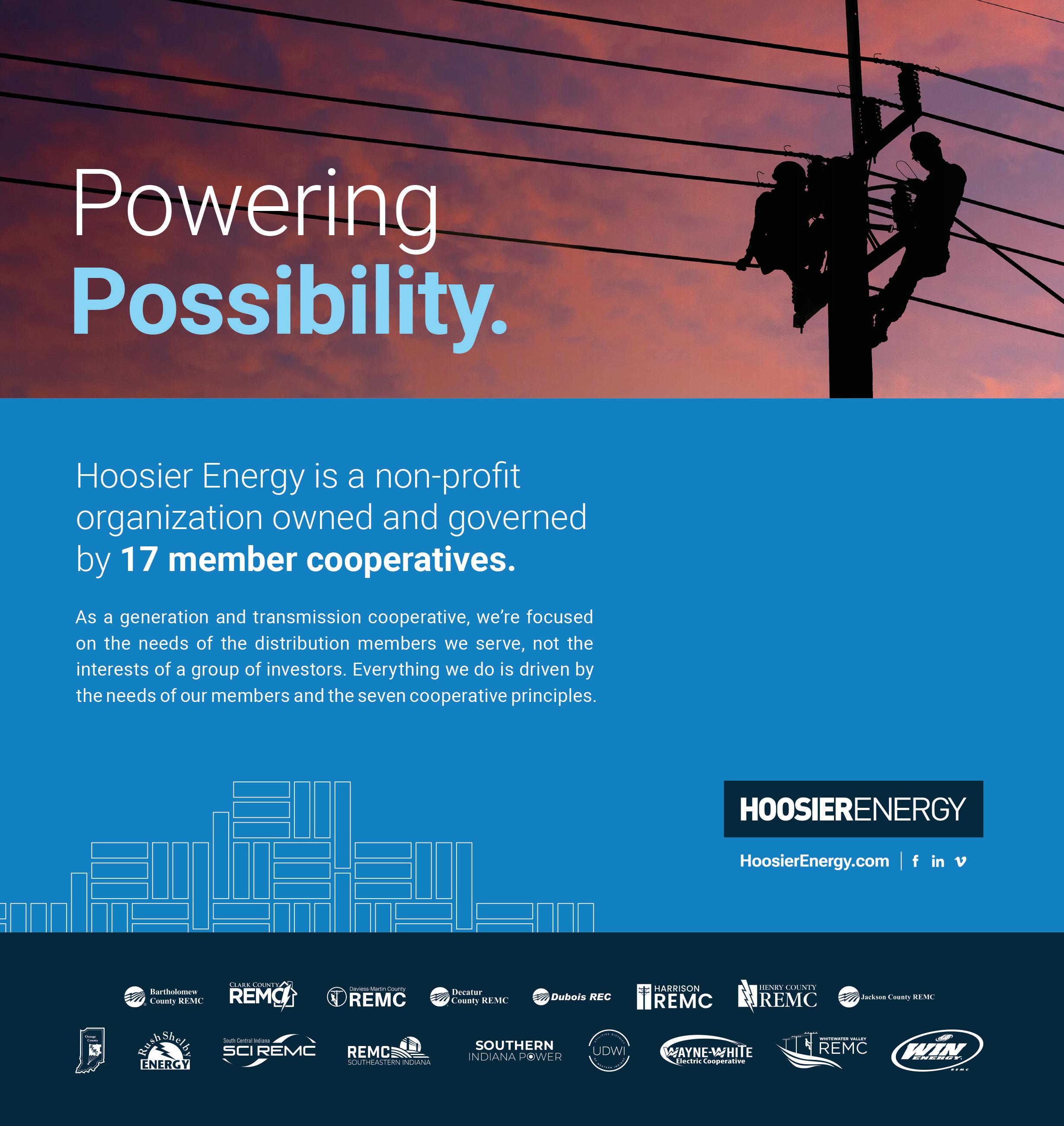Learn about the return of capital credits, pages 6 and 7
Harrison REMC’s

GUIDING MEMBERS TOWARD
Cooperative energy advisors provide education and practical power solutions
JUNE 2025







Learn about the return of capital credits, pages 6 and 7

Cooperative energy advisors provide education and practical power solutions
JUNE 2025






You may have noticed information recently about your cooperative’s Annual Meeting in this magazine. Being a member of an electric cooperative offers many benefits along with some responsibilities. Your cooperative is guided by seven principles, including “Democratic Member Control.” The Annual Meeting is when directors are elected. As a member, it’s important to vote and actively participate in choosing who will help manage the co-op.
But Annual Meetings are about more than just director elections. They provide an opportunity to check in with your co-op and hear about the past year’s successes and updates on the industry. This is also a great time to become more familiar with co-op-sponsored programs, such as rebates and youth opportunities.
Annual Meetings also allow you to connect with your community. Last year, I had the chance to attend the Orange County REMC Annual Meeting. I was surprised by the number of attendees and the strong sense of community in the room. Neighbors greeted one another and sat down to share a meal. There was plenty of time to catch up and enjoy the live music before the business meeting. Most of the crowd stayed until the end, when names were drawn for great prizes like TVs and power tools.
Everyone is so busy these days. I know it’s difficult to add extra events to your calendar. However, I encourage you to make time for your co-op’s Annual Meeting or Member Appreciation Day, or stop by their booth at your local fair. Your co-op works hard all year to provide reliable power and helpful programs for its members. Connect with them at an event and be an active member.


Britt Davis Editor bdavis@indianaec.org
On the menu: September: Submit your favorite smoothie recipes, deadline July 1. If we publish your recipe on our food pages, we’ll send you a $10 gift card.
Giveaway: Enter to win half a dozen cookies from Rosie’s Place. Visit indianaconnection.org/talk-to-us/contests or send your contact information to the address below. The deadline to enter is June 30.
Three ways to contact us: To send us recipes, photos, letters and entries for gift drawings, please use the forms on our website indianaconnection.org; email info@indianaconnection.org; or send to Indiana Connection, 11805 Pennsylvania Street, Carmel, IN 46032.
VOLUME 74 • NUMBER 12 ISSN 0745-4651 • USPS 262-340
Published monthly by Indiana Electric Cooperatives
Indiana Connection is for and about members of Indiana’s locally-owned, not-for-profit electric cooperatives. It helps consumers use electricity safely and efficiently; understand energy issues; connect with their co-op; and celebrate life in Indiana. Over 311,000 residents and businesses receive the magazine as part of their electric co-op membership. The average printed and mailed cost per issue is 54 cents.
CONTACT US: 11805 Pennsylvania Street Carmel, IN 46032 317-487-2220
info@indianaconnection.org IndianaConnection.org
INDIANA ELECTRIC COOPERATIVES OFFICERS: Steve McMichael President Dr. Richard Leeper Vice President
Jamey Marcum Secretary/Treasurer
John Cassady CEO
EDITORIAL STAFF:
Britt Davis Editor
Mandy Barth Vice President of Communication
Lauren Carman Communication Manager
Ashley Curry Production and Design Coordinator
Holly Huffman Communication Support Specialist
Amber Knight Creative Manager
Kiley Lipps Graphic Designer
ADVERTISING:
American MainStreet Publications Cheryl Solomon, local ad representative; 512-441-5200; amp.coop
Paid advertisements are not endorsements by any electric cooperative or this publication.
UNSOLICITED MATERIAL:
Indiana Connection does not use unsolicited freelance manuscripts or photographs and assumes no responsibility for the safekeeping or return of unsolicited material.
SUBSCRIPTIONS: $12 for individuals not subscribing through participating REMCs/RECs.
CHANGE OF ADDRESS:
If you receive Indiana Connection through your electric co-op membership, report address changes to your local co-op.
POSTAGE:
Periodicals postage paid at Indianapolis, Indiana, and at additional mailing offices.
POSTMASTER: Send change of address to: Indiana Connection, 11805 Pennsylvania Street, Carmel, IN 46032. Include key number.
No portion of Indiana Connection may be reproduced without permission of the editor.
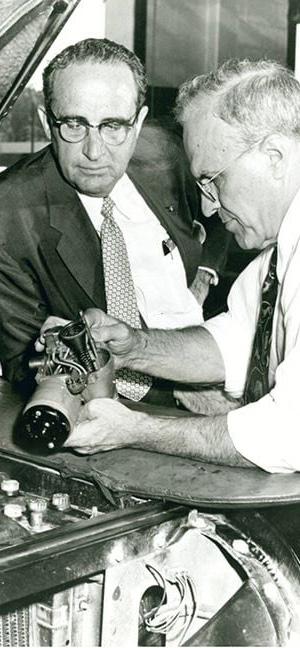



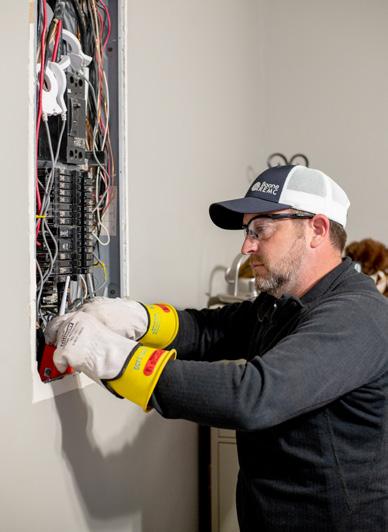
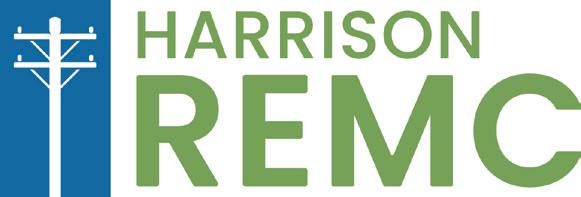
www.harrisonremc.com
CONTACT US
812-738-4115
812-951-2323
Fax: 812-738-2378
Click on “Contact Us” at www.harrisonremc.com.
OFFICE HOURS
7:30 a.m.–4:30 p.m., Monday–Friday
DRIVE-THRU WINDOW HOURS
7:30 a.m.–4:30 p.m., Monday–Friday
LOBBY HOURS
8 a.m.–4 p.m., Monday–Friday
STREET ADDRESS
1165 Old Forest Road, Corydon, IN 47112
MAILING ADDRESS
P.O. Box 517, Corydon, IN 47112
SERVICE INTERRUPTIONS
To report a power outage, please call 812-738-4115 or 812-951-2323.
BOARD OF DIRECTORS
David Poe (Floyds Knobs), President
Darin Duncan (Elizabeth), Vice President
Craig Engleman (Corydon), Secretary/Treasurer
Pat Book (Palmyra)
Brian Koetter (Borden)
David Walther (Lanesville)
C. Todd Uhl (Corydon)
Danny Wiseman (Mauckport)
Roy Zimmerman (Laconia)
LED security light rental; a community solar program; heating and cooling rebate program; surge protection information; home energy seminars; payment via phone, online, e-check, automatic payment plan and budget billing; REMC gift certificates; prepaid billing; and a mobile app with notification options!
The mission of Harrison REMC is to provide a well-informed membership with superior, competitively priced electric and related member service(s), accomplished by highly trained, committed employees. It is further the mission to improve the quality of life of the member-owners by promoting community, economic development and energy efficiency activities.
Harrison REMC employees and directors would like to thank everyone who attended the 87th Annual Meeting of Harrison REMC!
What a crowd we had at the Annual Meeting on May 5 at the Harrison County fairgrounds. Members played bingo, visited booths, and enjoyed some food and ice cream.
The children had a good time making a bird feeder. The REMC offered a drive-thru voting event on May 6 at the office in Corydon.
It was wonderful to see so many familiar faces at both events.
A total of 1,688 registered

members attended the two 2025 Annual Meeting options.
After 21 years on the REMC board, Director Brian Koetter chose not to run again for his district. Leah Huber ran for the position unopposed and will fill the seat for District 3. There were no opposing candidate petitions for the other two districts, and Pat Book (District 2) and Craig Engleman (District 6) were seated for another three years.
The Annual Meeting video and financials are available to view on the website.
Thank you to all the members who participated in this year’s Annual Meeting.


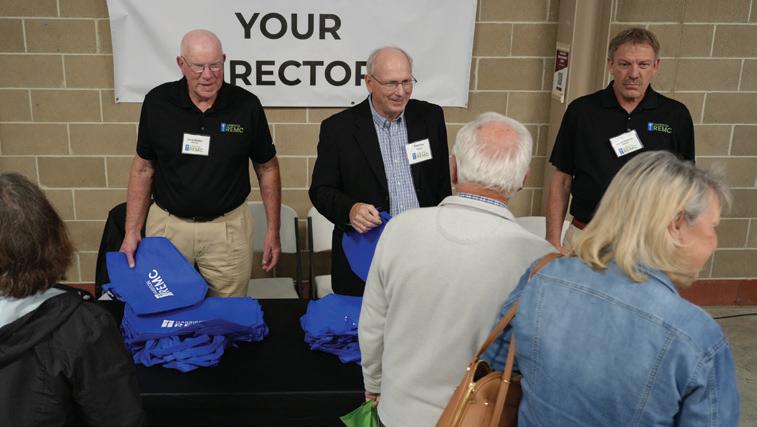

The Harrison REMC Board of Directors has approved paying capital credits in the amount of $1.5 million for portions of 1989, 1990, and 2019. The board is excited to return your investment in your electric cooperative with this capital credit retirement.
Capital credits are one of the benefits of membership with a notfor-profit electric cooperative like Harrison REMC. As a member of Harrison REMC during these years, you helped provide the funding to build and maintain the electric system. Since Harrison REMC is a not-for-profit cooperative, all funds not used to pay the wholesale power bill and operating expenses
are invested in the cooperative’s electric facilities.
The capital credit check or bill credit you will receive reflects your portion of the margins (profit) made and invested during that period. This general retirement has returned over $13.50 million to members participating in the cooperative’s business. Unlike investor-owned utilities that pay dividends to their stockholders, who are often far removed from the service provided, cooperatives allocate and return their margins to the members who used the service and provided an important investment.
We believe this is just one of the cooperative differences that make serving you and our communities a pleasure.
Refunds will be issued before the end of July
If you are unfamiliar with capital credits, read on for a more detailed description of what they are, who gets paid, and how allocations are made. We will provide more information about the return of capital credits in future issues of Indiana Connection. If you have any questions regarding this announcement, please call our office at 812-738-4115 or 812-951-2323 for further information.
As a not-for-profit electric cooperative, Harrison REMC is obligated to allocate, by credits to a capital account, all amounts in excess of operating costs and expenses at the end of each fiscal year. This patronage capital is allocated to each member of the cooperative based on their contribution of patronage (revenue) for that particular year.
To determine your capital allotment as a member of Harrison REMC, first determine your electric bill amount for the year (your bill amounts, less tax, and less miscellaneous charges), then multiply this amount by the following allocation factor — 8.0592%.
WHAT’S THE DIFFERENCE BETWEEN ALLOCATED AND RETIRED CAPITAL CREDITS?
Allocated capital credits appear as an entry on the co-op’s permanent financial records and reflect your equity or ownership in Harrison REMC. When capital credits are retired, a check or bill credit is issued to you, and your equity in the co-op is reduced.
HOW ARE CAPITAL CREDITS CALCULATED?
The amount of capital credits you earn in a given year is based on the amount of capital you contribute to the co-op by paying your monthly bills. The more electric service you buy, the greater your capital credits account. The sum of your monthly bills for a year is multiplied by a percentage to determine your capital credits.
WHAT DO I HAVE TO DO TO START ACCUMULATING CAPITAL CREDITS?
Harrison REMC calculates capital credits for every member who purchased electricity during a year in which the utility made a profit. No particular action is required to
start a capital credits account; your membership activates it.
WHAT PERCENT OF MY BILL IS ALLOCATED AS CAPITAL CREDITS?
The percentage of your total payment allocated as capital credits varies from year to year, depending on the amount of profits recognized on the REMC’s income statement. Capital credits are only allocated for a year in which the REMC had a profit. Since capital credits are a member’s share of the profits, no credits are allocated for a year without any profit.
DO I HAVE TO BE A MEMBER FOR AN ENTIRE YEAR TO EARN CAPITAL CREDITS?
No. Capital credits are calculated based on a member’s monthly bills. You will accumulate some capital credits if you are billed for service for even one month.
WHAT HAPPENS TO THE CAPITAL CREDITS OF A MEMBER WHO DIES?
The traditional option is for an estate to be paid out on the same schedule as other members as part of normal retirements for a given year of service. Another option is
for heirs of a deceased member to request the capital credit payout early by choosing to receive a discounted present value amount. With all options, an authorized representative or family member for the estate must request the credits by submitting the required documentation.
CAN THE CAPITAL CREDITS BE SENT TO A CHARITY?
If desired, members or heirs can donate the refunds to a charity of their choice.
WILL I RECEIVE A CAPITAL CREDIT CHECK OR BILL CREDIT EVERY YEAR?
Not necessarily. When considering a retirement, the board analyzes the cooperative’s financial health to determine whether a retirement or payment can occur.
WHAT HAPPENS TO MY CAPITAL CREDITS WHEN I LEAVE THE HARRISON REMC SERVICE AREA?
They remain on the books in your name until they are retired. You should ensure that the REMC has your current mailing address.
• Peggy Cook, Depauw: Spice Kit and $25 Cracker Barrel Gift Card, Brownstown Electric & Sunbelt Solomon, LLC
• Fred Naegele, Corydon: Spice Kit and $25 Cracker Barrel Gift Card, Brownstown Electric & Sunbelt Solomon, LLC
• Juanita Deweese, Corydon: Stadium and Camp Chair and $25 Amazon Gift Card, John Jones & Custom Business Systems
• Lucy Keinsley, Lanesville: Toy Case Tractor and $25 Amazon Gift Card, Jacobi Sales & Custom Business Systems
• Dale Brunner, Corydon: Gift Basket and $25 Starbucks Gift Card, First Savings Bank & Matrix
• Charlotte Adams, Depauw: Trouble Light with USB Charging, Eckarts Supply
• Amy Nolen, Borden: $25 Jay C Gift Card, S&M Nix
• Francis Rothrock, Depauw: $25 Jay C Gift Card, S&M Nix
• Andrew Eschbacher, Laconia: $25 Jay C Gift Card, S&M Nix
• Hattie Grace, Lanesville: $25 Cracker Barrel Gift Card, S&M Nix
• Gregory Duncan, Georgetown: $25 Cracker Barrel Gift Card, S&M Nix
• Carl Strahl, Georgetown: $25 Cracker Barrel Gift Card, S&M Nix
• Donny Whittaker, Depauw: $25 Red Barn Diner Gift Certificate, S&M Nix
• James Monroe, Corydon: $25 Red Barn Diner Gift Certificate, S&M Nix
• Diane Metz, Elizabeth: $50 Red Barn Diner Gift Certificate, S&M Nix
• Everett Harl, Elizabeth: $25 Cabella Gift Card, United Utility Supply
• Michael Schubert, Elizabeth: $25 Visa Gift Card, United Utility Supply
• Scott Oliver, Corydon: $50 Visa Gift Card, United Utility Supply
• Lee Motsinger, Corydon: $50 Lowe's Gift Card, United Utility Supply
• Danny Bullington, Ramsey: $50 Lowe's Gift Card, United Utility Supply
• David Schulz, Corydon: $50 Cabella Gift Card, United Utility Supply
• David Hubbard, Laconia: $50 Gift Card (Multiple Options), Alpha Engineering
• Mary Allen, Mauckport: $50 Gift Card (Multiple Options), Alpha Engineering
• Charles Nolot, Depauw: $75 Home Depot Gift Card, GDS Associates, Inc.
• Jeffrey Casper, Elizabeth: $50 Heritage Ford Gift Certificate, Heritage Ford
• Stephen Miller, Corydon: $50 Home Depot Gift Card, Tech Products, Inc.
• Jeffry Brunner, Ramsey: $50 Bill Credit, JB Lawn Service
• Thomas Withers, Elizabeth: $50 Bill Credit, JB Lawn Service
• Glen Westerfield, Corydon: $50
Bass Pro Shops Gift Card, Altec
• Kathleen Leuthart, Depauw: $50
Bass Pro Shops Gift Card, Altec
• Jerry Schneider, Corydon: $50 Bass Pro Shops Gift Card, Altec
• Beverly, McCloud, Georgetown: $50 Bass Pro Shops Gift Card, Altec
• Richard Gelhausen, Corydon: $50
Bass Pro Shops Gift Card, Altec
• Robert Zimmerman, Laconia: $50 Joe Huber’s Family Farm and Restaurant Gift Card, Charlie's Used Cars, Inc.
A MEMBER OF THE CREDENTIAL AND ELECTION COMMITTEE DREW PRIZES. RESULTS ARE ALSO POSTED ON HARRISONREMC.COM
• Penny Zeller, Palmyra: $50 Joe Huber’s Family Farm and Restaurant Gift Card, Charlie's Used Cars, Inc.
• Robert Morris, New Salisbury: $50 Sam’s Tavern Gift Card, Charlie's Used Cars, Inc.
• Vincent Tuell, Corydon: $50
Sam’s Tavern Gift Card, Charlie's Used Cars, Inc.
• Alan Feller, Corydon: $50 Bill Credit, Townsend
• Thomas Little, Georgetown: $50 Bill Credit, Townsend
• Jeff Harbeson, Corydon: $50 Bill Credit, Townsend
• Depauw Methodist Church, Elizabeth: $50 Bass Pro Gift Card, Monroe Shine
• Brian Engleman, Corydon: $50 Bass Pro Gift Card, Monroe Shine
• Nellie Burks, Depauw: $50 Visa Gift Card, Monroe Shine
• Debora Newman, Elizabeth: $50
Visa Gift Card, Monroe Shine
• Shirley Binkley, Corydon: $50 Bill Credit, Milsoft
• Holly Cunningham, Corydon: $100 Bill Credit, Milsoft
• Larry Crosier, Corydon: $100 Bill Credit, Milsoft
• Mary Conrad, Corydon: $100
Visa Gift Card, Monroe Shine
• Christopher Cherry, Corydon: $100 Amazon Gift Card, Cooperative Response Center, Inc.
• J Mark Draper, Corydon: $100 Bill Credit, Townsend

While many homeowners gasp at the price tag of a new HVAC system, advanced planning can prevent money from floating out of their wallets.
If your HVAC system is over 10 years old and struggles to keep you comfortable this summer, it may be time to plan for a replacement. Planning proactively can help you save money: you can seek multiple bids and schedule the project when contractors might run promotions. Homeowners should take a few steps to get the most out of their new system.
First, properly seal any air leaks in your home. Search your home, high and low. The most important leaks to seal are in your attic and basement or crawlspace. Framing and places where plumbing,
electrical wiring, or ducts poke through the ceiling also need to be checked. Sealing air leaks will help keep your conditioned air inside.
Next, ensure your home is properly insulated. This step should be taken after sealing air leaks. If part of your HVAC ductwork is located in the attic space, it is especially important to seal it and bury it in insulation. By adding insulation properly, your HVAC system will have an easier time maintaining the temperature in your house, reducing your energy use and increasing your savings.
Now that you’re ready, make sure a proper heat-load calculation is done for your new equipment . By properly air-sealing and insulating your home, you may need smaller equipment to heat and cool it, keeping you comfortable. A smaller,
correctly sized, and more energyefficient system will reduce your electricity use, which will help save you money years into the future. An HVAC contractor should do a heatload (also known as a Manual J) calculation to determine the properly sized equipment for your house.
A bigger system isn’t necessarily better. Systems that are larger than needed will short-cycle, reducing the life of the HVAC system. They may also not remove moisture as intended. By planning ahead, you can ensure your home is ready for a new system that can keep you cozy no matter what Mother Nature may be plotting. Contact your electric cooperative for support and tips on improving your energy use. Don’t sweat high costs to keep you comfortable in your home.
by Andrew Wray Energy Advisor
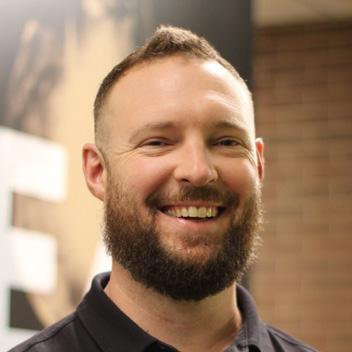
















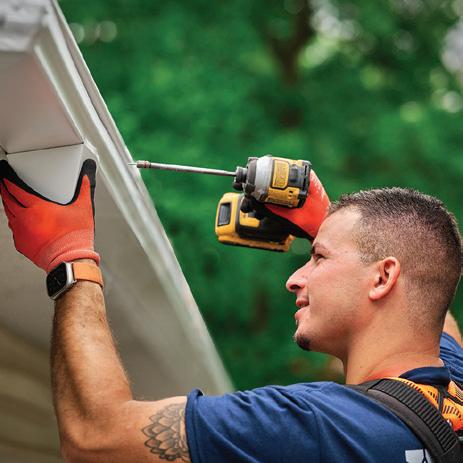




Wayne County is home to Hoosier Hill, Indiana’s highest natural elevation. At 1,257 feet above sea level, its summit is nestled in a wooded area surrounded by farmland. After repeated thefts of wooden signs marking “Indiana’s Highest Point,” Wayne County’s government replaced them with a more permanent solution, an engraved boulder.
Indiana’s Antique Alley, recognized as one of the “Top 10 Choice Antiquing Destinations” by Midwest Living Magazine, is a 66-mile loop stretching between Richmond, Indiana, and Knightstown, Indiana. Over 1,200 antique dealers offer a wide range of vintage treasures, including sea glass, furniture, jewelry, pottery, and more. Wayne County’s historic Cambridge City is the heart of Antique Alley with 11 antique shops nestled within a three-block radius.
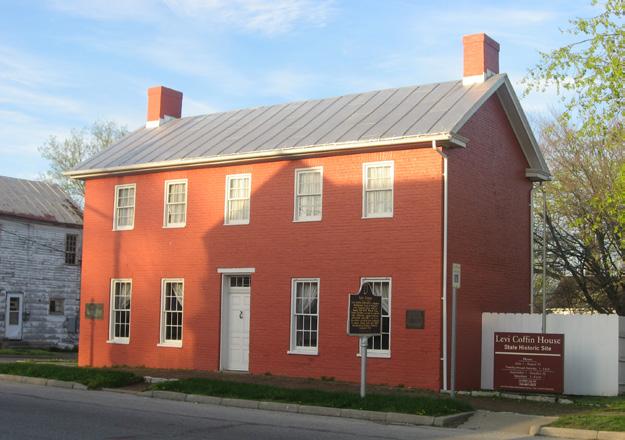
Levi Coffin, known as the “President of the Underground Railroad,” was born in Guilford County, North Carolina, in 1798, but later settled in Wayne County. As Quaker abolitionists, Coffin and his wife, Catherine, used their home in Fountain City, Indiana, as a safe house for runaway slaves. Their Federal-style brick home, built in 1839, sheltered nearly 2,000 freedom seekers on their journey to the northern U.S. and Canada. The Coffins supplied food, clothing, and protection to those escaping slavery, and their home became known as the Underground Railroad’s “Grand Central Station.” The Levi and Catherine Coffin House is a National Historic Landmark and has been restored to its 1840s appearance for visitors to tour.


Ralph Teetor, the inventor of cruise control, was born in Hagerstown, Indiana, in Wayne County in 1890. His inspiration to create the device came while riding with his family’s lawyer, Harry Lindsay, who would slow down his driving while talking and speed up while listening. Teetor spent 10 years fine-tuning his speed control device before patenting it in 1945. He initially named his invention “Controlmatic,” “Touchmatic,” and “Pressomatic” before he trademarked it as “Speedostat” in 1950. Chrysler was the first to use the device commercially in 1958, and Cadillac soon followed, marketing it as “cruise control.”
FOUNDED: 1811
NAMED FOR: Gen. Anthony Wayne, a Founding Father POPULATION: 66,553
COUNTY SEAT: Richmond INDIANA COUNTY NUMBER: 89
Letters have been edited for length and clarity
“I always enjoy your magazine and eagerly wait to read it every month. The April 2025 issue was especially interesting. Brian D. Smith’s article about Ernie Pyle was excellent, and I thank you for printing it. Hopefully, this might inspire younger readers to investigate other WWII heroes and celebrities.
Your County, Indiana Eats and Travel sections are always interesting and encourage me to visit more places. Thank you for publishing such an interesting magazine!”
— Deborah Davidson
“I can’t tell you just how much I loved your article on Ernie Pyle. I’m a 66-year-old man from Rising Sun, Indiana. My dad, a WWII veteran, landed on Utah Beach with the 4th Division. When I was a kid, my dad talked about Ernie Pyle so much I thought he and Hoagy Carmichael had lived down the road from us. Reading the pages made me think of my dad and caused my eyes to tear up just a little. My dad and I didn’t always get along, but these are memories I will always cherish.”
— Jerry Bovard
“Thank you for the excellent article on war correspondent Ernie Pyle. I enjoyed the photos as well as the interesting details about his life. I knew very little about this famous man when I attended Indiana University in Bloomington from 1966 to 1970. I look forward to a future visit to campus to seek out the statue placed outside of Franklin Hall, in his honor.”
— Nancy Arata Teagarden
I was a child when WWII started, so I didn’t know about Ernie Pyle’s articles. The story was wonderful, and I was glad to learn more about him! Since I lived in Fountain County for years, I’ve been to Dana to see his memorial. When my husband and I traveled to O’ahu, Hawaii, we saw his gravesite in the National Memorial Cemetery of the Pacific. The fact that you went to Normandy and read his articles on that battle makes one want to find those articles and read more of his writings.
— Virginia Bennett
Our Marketplace offers maximum exposure for your business or organization at a minimal cost.
Please contact Cheryl Solomon, 847-749-4875 or cheryl@amp.coop , for other small business advertising opportunities in Indiana C onnection






Lucky Turtle Grill and Lucky Moose Lounge offer 185 menu items to please any crowd
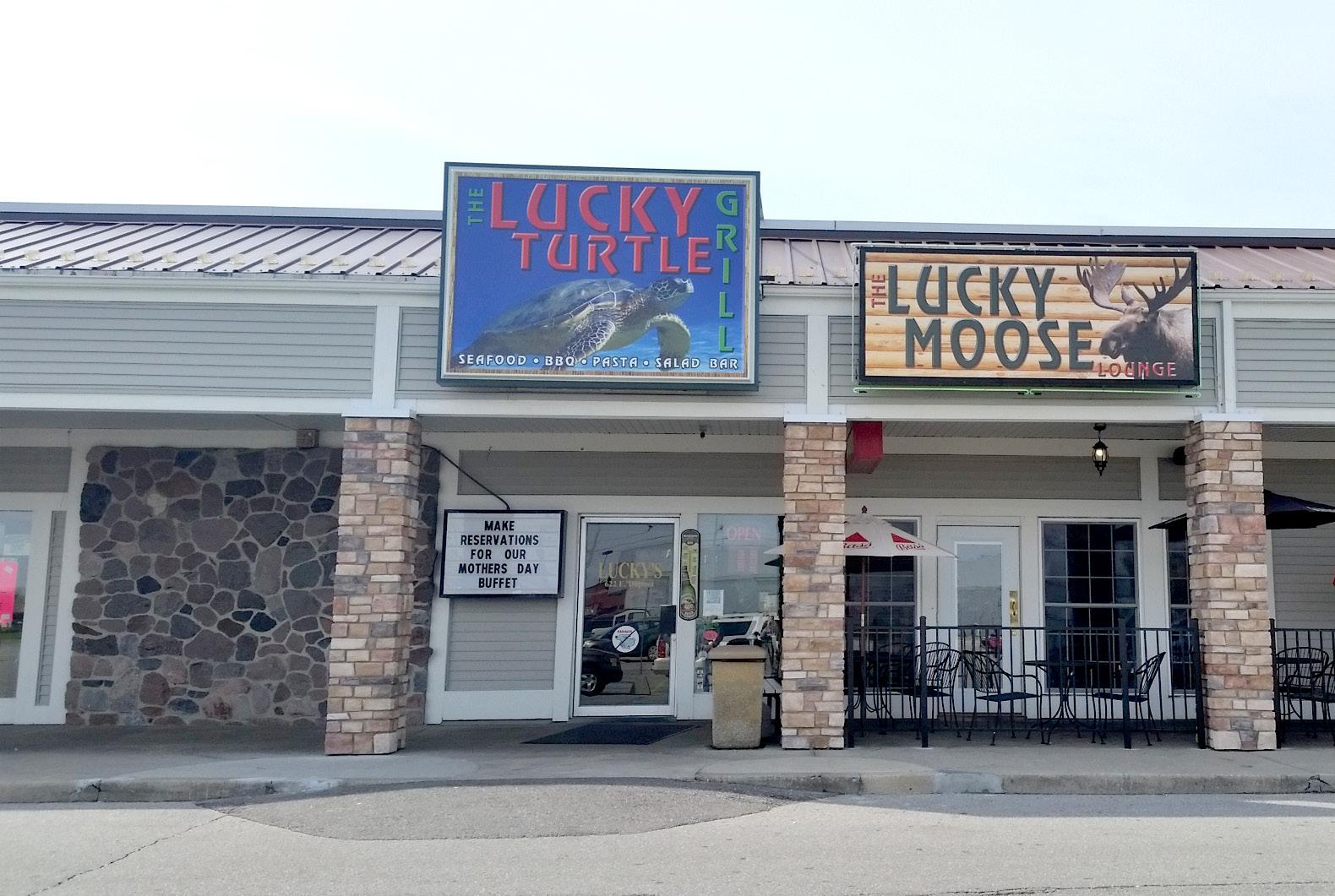
The Lucky Turtle Grill and Lucky Moose Lounge in Fort Wayne is best known for its exceptional seafood and extensive menu, which has evolved under the stewardship of longtime restaurateur Mark Melchi. Approaching his 75th birthday and 45 successful years in the restaurant business, Melchi has created a well-loved establishment through his commitment to quality and value.
"We've always had a fairly substantial menu. It started off at the Munchie Emporium down on Taylor Street with 13 sandwiches, and then we ended up with 13 pages," Melchi laughed. Today, Lucky's features 185 menu items spanning land and sea.
The restaurant's clever naming scheme highlights its specialties. The "Turtle" represents the sea, while the "Moose" suggests hearty landbased fare. This duality extends to the physical space as well. The Lucky Turtle Grill features a relaxed beach theme, while the Lucky Moose Lounge showcases a rustic cabin aesthetic, complete with split logs and a canoe suspended from the ceiling.
Fresh seafood is the foundation of Lucky’s menu, with triggerfish, various shrimp preparations, and handcrafted crab cakes ranking among its top sellers. The restaurant hand-trims its salmon in-house from whole sides. Beyond seafood, Lucky's offers diverse options, including popular flatbreads like the very meaty Full Moose and the Greek.
Melchi's business approach gives Lucky's a competitive advantage in quality and pricing. "Since we're an independent restaurant, I'm not stuck with buying contracts through national suppliers. I do a lot of shopping. I like to look for our own produce," he said.
His strategy proved invaluable during the pandemic when crabmeat prices skyrocketed. Melchi drove 700 miles to secure affordable crabmeat, allowing the restaurant to maintain menu and pricing stability.
"We've kept our menu together and kept our prices low. We've had two fairly small price increases in the past five years," Melchi proudly shared.
The restaurant remains a family business, with Melchi's daughter, two granddaughters, and son working alongside a staff of about 80% long-term employees. Melchi says he credits much of the restaurant’s success to the devotion of his longterm employees.
After managing four restaurants simultaneously, Melchi now focuses solely on Lucky's and the customer experience.
"Business is great as long as we can take care of the people coming through the door," he said.
Melchi's commitment to quality, value, and personal service continues to make Lucky's a top destination for foodies in Fort Wayne.
Stephanie Bernaba is a freelancer with national reach who thrives on topics like food and entertainment.






































When heading out on vacation, you probably already have a long list of things to remember to do. To make sure your trip and home are safer, you might want to add a few items around electrical safety. Indiana Electric Cooperatives has a list of safety tips for you to keep in mind.
You might think you’re fooling burglars if you leave a light or two on for your vacation. But bulbs can get very hot or make the fixture hot when left on for extended periods, creating a potential hazard.
To keep some lights on, use a motion-sensing outdoor lighting system and programmable timers for inside lights. Today’s timers usually have settings, including a randomized setting, which creates the illusion that different rooms are in use at various times.
Unplugging all appliances and electronics that aren’t necessary while you’re gone can help secure your electrical system. This can help reduce the chances of an electrical fire and prevent potential disasters in case of power surges or lightning strikes. You might unplug items like coffee makers, toasters, televisions, and home entertainment systems.
You shouldn’t let your guard down because you’re away from home. Keep your eyes open for electrical hazards when staying at a hotel, condo, or short-term rental. When you check in, look for overloaded outlets, extension cords in use, outlets that get too hot, and the smell of overheated wires. Exercise caution when you find issues.
If they’re too dangerous to handle yourself, let management know immediately. If they don’t fix the situation or refund your deposit, go somewhere else and report them to authorities.
It can be very frightening to strike a utility pole. That’s especially true when you’re already in an unfamiliar place. Always stay in the car if you hit a utility pole. Power lines can fall and still be energized. If they fall on or near your vehicle, you can easily be electrocuted if you don’t stay in the car. Let others know to stay back as well. Stay in the vehicle until an electric utility responder lets you know it’s safe to exit. If you encounter an accident involving power lines, call 911 and warn those involved of the dangers. Chris Adam is a freelance writer from Lafayette.



















Upgrade your bathroom, upgrade your life. With a new walk-in shower, you can make sure your bathroom ages as gracefully as you do. is shower was designed by experts, with you in mind, focusing on safety and convenience when it matters most. Discover how a walk-in shower can help reduce the risk of falling, giving you the freedom to enjoy your bathroom again.












✓ Commercial Grade Non-Slip Floor
✓ Easy-to-reach Shower Wand
✓ Professionally Installed in 1 day
✓ Fold Down Safety Seat
✓ Luxurious 8" Rainfall Shower Head
✓ Ergo L Shaped Grab Bar
✓ Lifetime Warranty
✓ Optional Barrier Free Wheelchair Accessible



One of summer’s most popular fruits is the star of these delicious desserts

Yvonne Bertke, St. Meinrad
1½ cups all-purpose flour
½ tsp salt
¾ tsp baking powder
½ tsp baking soda
¾ cup sugar
Zest of one lemon
2 eggs, beaten
½ cup oil
1½ tsp fresh lemon juice
1 cup blueberries
1 cup grated zucchini, squeezed dry
GLAZE (optional)
1 cup powdered sugar
Pinch of salt
4 tsp fresh lemon juice
Preheat the oven to 350 F and prepare a 9x5-inch loaf pan by spraying it with cooking spray, laying a piece of parchment or waxed paper in the bottom of the pan, spraying again, and lightly dusting with flour.
Mix flour, salt, baking powder, and baking soda in a small bowl and set aside.
Mix the sugar and lemon zest in a large bowl. Use a large mixing spoon to press the zest into the sugar until it is pale yellow and uniformly mixed. Add the dry zucchini to the lemon sugar, along with the eggs, oil, and lemon juice. Beat it all together until uniformly mixed.
Stir the dry ingredients into the wet ingredients and mix thoroughly. Fold in the blueberries. Pour the batter into the prepared loaf pan and smooth the top. Bake for 40 to 50 minutes until the loaf is golden brown and a toothpick inserted in the center comes out clean. Cool 10 minutes in the pan on a wire rack, then loosen the loaf by running a butter knife along the edges. Remove the loaf from the pan, remove the paper from the bottom of the loaf, and finish cooling on the rack.
For the glaze, mix the ingredients and drizzle over the cooled loaf before serving. Store it wrapped in a cool, dry place or refrigerate. The bread can also be made in smaller, 5x3-inch loaves and baked for 30 to 40 minutes.
1½ cups all-purpose flour
¾ cup sugar
2 tsp baking powder
1½ tsp lemon zest
½ tsp ground nutmeg
¼ tsp salt
2 ⁄ 3 cup milk
¼ cup butter, melted
1 egg, room temperature, beaten
1 tsp vanilla
2 cups blueberries
TOPPING
¾ cup sugar
4½ cups all-purpose flour
2¼ cups melted butter
Combine flour, sugar, baking powder, lemon zest, nutmeg, and salt in a large bowl. Add milk, butter, egg, and vanilla. Beat for 2 minutes or until well blended. Pour into a greased 9x13-inch baking dish. Sprinkle with the blueberries.
In another bowl, combine sugar and flour, then add the butter. Toss with a fork until crumbly. Sprinkle over the top. Bake at 350 F for 40 minutes or until lightly browned.
EDITOR’S NOTE:
Frozen blueberries can be used instead of fresh in any of these recipes. If frozen is used, do not thaw as blueberry juice will affect the color of the batter.
9-inch graham cracker ready crust FOR THE CHEESE CUSTARD:
8 oz cream cheese, softened
1⁄ 3 cup sugar
1 tsp vanilla extract
2 eggs
Zest from 1 lemon, freshly grated FOR THE BERRY TOPPING:
2 cups blueberries
1⁄4 cup water
1⁄ 3 cup sugar
1 1⁄ 2 Tbsp cornstarch mixed with
1 Tbsp cold water

Preheat the oven to 325 F. To make the cheese custard, combine the cream cheese, sugar, and vanilla in a medium bowl and beat until thoroughly mixed and smooth. Add the eggs and beat well. Stir in the lemon zest. Pour into the pie shell and bake until just set, 25 to 30 minutes. Remove from the oven and let cool completely.

While the custard is baking, combine the berries, water, and sugar in a medium saucepan and bring to a boil. Reduce the heat and simmer, covered, for 5 minutes, stirring once or twice to prevent sticking. Remove from the heat and add the cornstarch mixture. Return to a boil and cook for one minute, stirring constantly until the mixture is thickened. Remove from the heat and cool until tepid. Spoon the berries over the custard. Chill for at least one hour before serving.
up new
People don’t always do what their doctor says, but when seasoned veteran emergency room physician, Dr. Philip B. Howren, says every senior should have a medical alert device, you better listen up.
“Seniors are just one fall away from being put in a nursing home,” Dr. Howren said. “With a medical alert device, seniors are never alone. So it keeps them living independently in their own home. That’s why seniors and their family members are snapping up a sleek new medical alert device that comes with no monthly bills ever,” he said.
Many seniors refuse to wear old style help buttons because they make them look old. But even worse, those medical alert sys -
tems come with monthly bills.
To solve these problems Universal Physicians, a U.S. company went to work to develop a new, modern, state-of-theart medical alert device. It’s called “FastHelp™” and it instantly connects you to free unlimited nationwide help everywhere cell service is available with no contracts, no deposits and no monthly bills ever.
“This slick new little device is designed to look like the pagers doctors wear every day. Seniors love them because it actually makes them look important, not old,” Dr. Howren said.
FastHelp is expected to hit store shelves later this year. But special newspaper promotional giveaways are slated for seniors in select areas. ■

■ NO MONTHLY BILLS: “My wife had an old style help button that came with hefty bills every month and she was embarrassed to wear it because it made her look old,” said Frank McDonald, Canton, Ohio. “Now, we both have FastHelp™, the sleek new medical alert device that our grandkids say makes us look ‘cool’ not old,” he said. With FastHelp, seniors never have to worry about being alone and the best part is there are no monthly bills ever.
contracts,
unlimited nationwide help with just
The phone lines are ringing off the hook.
That’s because for seniors born before 1961, it’s a deal too good to pass up.
Starting at precisely 8:30am this morning the Pre-Store Release begins for the sleek new medical alert device that comes with the exclusive FastHelp™ One-Touch E 911 Button that instantly connects you to unlimited nationwide help everywhere cell service is available with no contracts, no deposits and no monthly bills ever.
“It’s not like old style monitored help buttons that make you talk to a call center and only work when you’re at home and come with hefty bills every month. FastHelp comes with state-of-theart cellular embedded technology. That means
(Continued on next page)

(Continued from previous page) it works at home or anywhere, any time cell service is available whether you’re out watering the garden, driving in a car, at church or even hundreds of miles away on a tour or at a casino. You are never alone. With just a single push of the One-Touch E Button you instantly get connected to free unlimited help nationwide with no monthly bills ever,” said Jack Lawrence, Executive Director of Product Development for U.S. based Universal Physicians.
“We’ve never seen anything like it. Consumers absolutely love the sleek new modern design and most of all, the instant rebate that practically pays for it and no monthly bills ever,” Lawrence said.
FastHelp is the sleek new medical alert device with the best of combinations: a quality, high-tech engineered device that’s also an extremely great value because there are no monthly bills ever.
Better still, it comes with no contracts, no deposits and no monthly bills ever – which makes FastHelp a great choice for seniors, students and professionals because it connects to one of the largest nationwide networks everywhere cell service is available for free.
And here’s the best part. All those who already have an old style monitored medical alert button can immediately eliminate those monthly bills, which is why Universal Physicians is widely advertising this announcement nationwide.
“So if you’ve ever felt a medical alert device was too complicated or expensive, you’ll want to get FastHelp, the sleek new medical alert device with no monthly bills,” said Lawrence.
The medical alert device slugfest was dominated by two main combatants who both offer old style monitored help buttons that come with a hefty bill every month. But now Universal Physicians, the U.S. based
heavyweight, just delivered a knockout blow sending the top rated contenders to the mat with the unveiling of FastHelp.
It’s the sleek new cellular embedded medical alert device that cuts out the middleman by instantly connecting you directly to highly trained 911 operators all across the U.S. There’s absolutely nothing to hook-up or install. You don’t need a land line and you don’t need a cell phone. Everything is done for you.
“FastHelp is a state
of the art medical alert device designed to make you look important, not old. Old style monitored help buttons you wear around your neck, or require expensive base station equipment or a landline are the equivalent of a horse and buggy,” Lawrence says. “It’s just outdated.”
Millions of seniors fall every year and spend hours lying on the floor helpless and all alone with no help.
But seniors who fall

and get immediate help are much more likely to avoid getting sent to a nursing home and get to STAY living in their own home independently.
Yet millions of seniors are still risking their safety by not having a medical alert device. That’s because seniors just can’t afford to pay the monthly bills that come with old style medical alert devices.
That’s why seniors
born before 1961 are rushing to cash in the whopping $150 instant rebate before the 21 day deadline ends.
So there’s no need to wait for FastHelp to hit store shelves later this year because seniors born before 1961 can get it now just by using the $150 instant rebate coupon printed in today’s newspaper before the 21 day deadline ends. If lines are busy keep trying, all calls will be answered. ■
Use the rebate coupon below and call this Toll-Free Hotline: 1-800-330-4294 DEPT.
IF BORN AFTER 1961: You cannot use the rebate coupon below and must pay $299 Call: 1-800-330-9423 DEPT. HELP8536
THE BOTTOM LINE: You don’t need to shop around. We’ve done all the leg work, this deal is too good to pass up. FastHelp with the instant rebate is a real steal at just $149 and shipping and there are no monthly bills ever.
PROS: It’s the sleek new medical alert device that comes with the exclusive FastHelp OneTouch E 911 Button that instantly connects you to free unlimited nationwide help everywhere cell service is available with no contracts or deposits. It connects you to the vast available network of cellular towers for free and saves seniors a ton of money because there are no monthly bills ever making this deal irresistible. Plus it’s the only medical alert device that makes seniors look important, not old.
CONS: Consumers can’t get FastHelp in stores until later this year. That’s why it’s so important for seniors born before 1961 to call the National Rebate Center Hotline within the next 21 days. For those who miss that deadline, the sleek little medical alert device will set you back over $300 bucks.









BY JODI BORGER

Across Indiana, energy advisors play a crucial role in empowering electric cooperative members to make informed decisions about their use of electricity. Their responsibilities go beyond simply answering member questions about energy consumption and providing guidance on energyefficient upgrades, as unique situations constantly arise and no two days are ever the same.

“Every day is different,” said Joe Spear, energy solutions coordinator for Carroll White REMC.
“Some days, I’m out in the field assessing high
consumption, helping members understand their energy use, and making recommendations. Other days, I manage rebate programs, coordinate with contractors, or work on marketing and communication efforts to get efficiency information out to our members.”
Spear’s background in HVAC and construction gave him a unique ability to assess homes, troubleshoot energy concerns, and provide practical solutions. Like many in the energy advisor role, Spear’s experience and skills aren’t necessarily those you learn in a classroom but have been built on decades of hands-on experience and working with people.
“I entered the heating and air conditioning world in 1991 as a
contractor,” said Spear. “I handled sales, service, and installation for over two decades before making the move to the cooperative in 2013.”
One of an energy advisor’s primary responsibilities is assisting members with high consumption and investigating potential causes of increased use. This is also an opportunity for advisors to educate members.
“First and foremost, it is just educating the members on how to know what things cost and how to control their use. People should know what their appliances cost to run,” said Spear. “If you plug in a space heater, you should have an idea of how much that will add to your bill.”

Matt Walters, lead member service technician at Boone REMC, echoed Spear, sharing that many residential
members, particularly those new to electric heating and appliances, are unaware of how certain devices impact their bills. Member inquires on high consumption often stem from a lack of knowledge regarding electric water heaters and space heaters.
“A lot of people assume a small space heater doesn’t add up to very much money when actually it can be very expensive to operate and should not be used to try and heat a room on a regular basis,” said Walters.
To assist members in identifying the causes of high consumption, Boone REMC and Carroll White REMC, like many cooperatives, offer various investigative services.
“During in-home visits, I try to figure out how members use different electrical devices,” said Walters. “I’m able to hook up to the meter base with an amp meter to determine if anything is running that the member might not be aware of and help calculate how the total kilowatt-hours for the bill are adding up.”
Additionally, Boone REMC provides more in-depth home energy evaluations.
“We also offer evaluations using infrared cameras to detect missing insulation or air leaks,” said Walters. Walters has uncovered numerous cases of hidden electricty waste, from well pumps stuck in the “on” position to malfunctioning heat
pumps, all of which significantly increased consumption.
“We often find causes of higher use that members are unaware of, such as stuck well pumps, heat pumps, and geothermal systems that are not working properly, driving up bills unnecessarily,” said Walters.
Both Walters and Spear encourage members to take a proactive approach to monitoring their kilowatt-hour consumption.
“Knowing what type of HVAC equipment you have and monitoring it regularly to make sure it’s working properly before waiting to find out when electric bills arrive is key,” said Walters. “Take advantage of SmartHub, which shows daily reads, to see if something is abnormal.”
Beyond addressing high consumption, energy advisors guide members through making their homes more efficient.
“Sealing air leaks and adding insulation are some of the most effective ways to improve energy efficiency,” said Spear. “Many people don’t realize how much heat they’re losing through their attic. I always tell them, ‘Seal it up first, then insulate, then look at upgrading appliances.’”
Some cooperatives around the state also offer various rebates and programs to assist members in their efficiency efforts.
continued on page 24
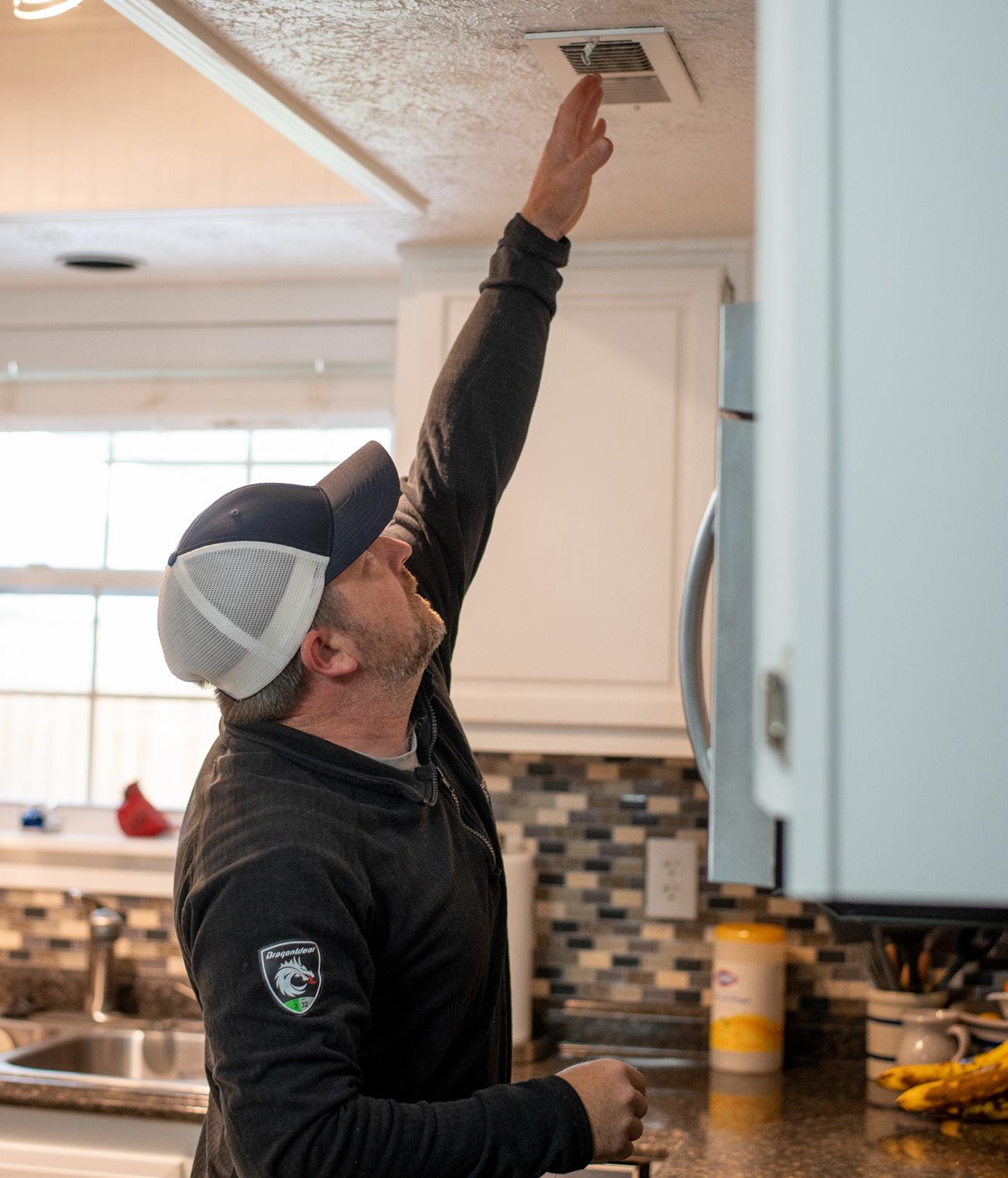
During home visits, energy advisors investigate many reasons for increased energy use, including potential air leaks.
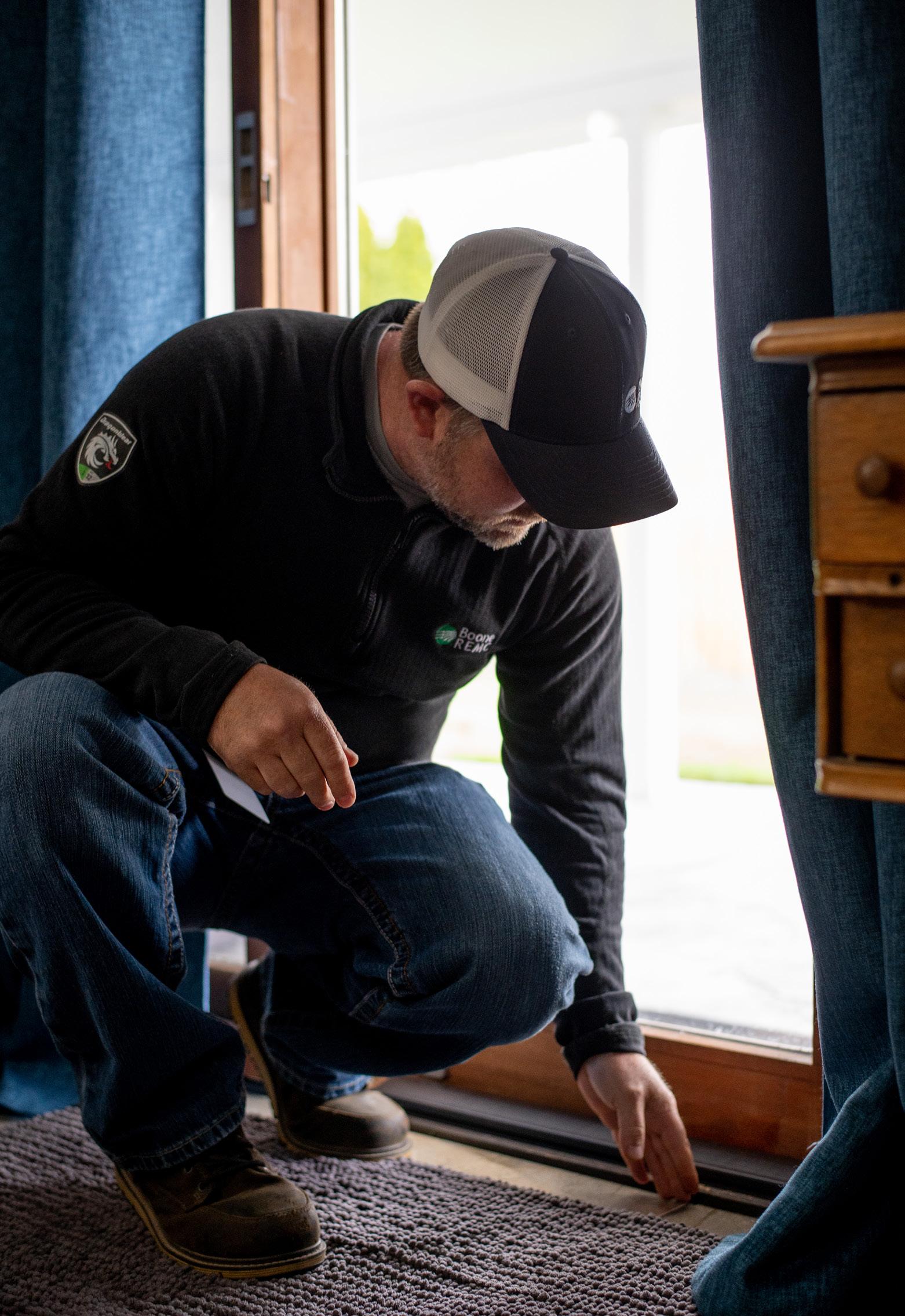
continued from page 23
“Every co-op is different, with a variety of rebates and programs. We manage rebate programs and work with Wabash Valley Power Alliance, our generation and transmission partner, for additional incentives,” said Spear. We also offer an energy efficiency loan program, a water heater program, and a geothermal loop program.”
Effectively communicating energy efficiency strategies is an ongoing effort.
Boone REMC takes a proactive approach by promoting energy efficiency through various communication channels, including targeted email campaigns.
“With the extremely cold weather earlier this year, we noticed a sharp rise in the number of accounts with unusually high use. We then worked with our communications department to create a targeted email campaign for these members,” said Walters.
“We use multiple channels — social media, SmartHub, radio ads, billboards, and Indiana Connection magazine — to get information out,” said Spear. “But one of the most effective methods has been working directly with contractors.”
Thanks to his HVAC background, Spear has built strong relationships with local contractors who, in turn, help spread the word about cooperative programs.
“When they’re out selling a new heating and cooling system, they know they can tell members about our rebates and efficiency programs,” said Spear. “It’s a win-win.”
Ultimately, the energy advisor’s role is about serving the cooperative’s members.
“We’re the ones that get to go in and engage with the member and talk with them at their kitchen table.” said Spear.
This hands-on approach allows them to build relationships, answer questions, and help members make informed decisions about their electricity use.
“I would never recommend something that isn’t in the member’s best interest,” said Spear. “Even though we’re an electric company, if a gas appliance makes more sense for a particular home, that’s what I’ll suggest. It’s about what’s best for them, not just about selling electricity.”
This cooperative mindset fosters trust and long-term success for both the co-op and its members. By prioritizing education and engagement, cooperatives create a scenario where energy efficiency, financial stability, and member satisfaction go hand-in-hand.
A common question Spear encounters is why an electricity provider would encourage customers to use less electricity. While it may seem counterintuitive, the cooperative model operates differently than traditional for-profit utilities. Because electric co-ops are not-forprofit, they never take in more money than they need, so all extra revenue eventually goes back to their members in the form of capital credits.
“That is an excellent question because, that is our bread and butter, you might say,” said Spear. “But, if you’re using electricity efficiently and you’re happy, then we’re going to be successful and happy.”
By educating members on how to use electricity efficiently, cooperatives help them manage costs while still supporting growth. When electricity remains affordable, members are more likely to expand their use in a sustainable way — whether upgrading appliances, adding new technologies, or making home improvements. The goal is not just to reduce consumption but to ensure members have the knowledge to make smart energy choices that align with their needs and lifestyles.
“As a co-op, we are focused on service excellence,” said Walters. “I strive to go above and beyond to help our members, as is demonstrated by our proactive use checks. That’s the cooperative difference — what I hope sets us apart.”
With energy costs fluctuating and new technologies emerging, having a knowledgeable advocate on hand is more valuable than ever. Indiana’s electric cooperatives aim to provide reliable power, but it’s the energy advisors that equip members with the tools and knowledge to use it wisely.
Want to make your home more efficient, but you’re not sure where to start? Here are some tips for reducing your electric bill:
• Close the curtains in the summer and open them in the winter.
• Unplug appliances when they’re not running.
• Turn off computers and video game consoles when they’re not being used.
• Caulk around drafty windows.
• Check the attic for the correct amount of insulation.
• Switch to LED lightbulbs.
• Plant a deciduous tree on the sunny side of your house. In a few years, the leaves will cool your home against the sun in summer and then fall off to warm it in the winter.
• Old cable TV boxes use a lot of energy. If yours is not ENERGY STAR-rated, call your cable provider and ask for a new one.
• If you have a major appliance — like a refrigerator, washing machine, or dryer — that’s more than 10 years old, don’t repair it. The energy efficiency of a newer model will likely pay for itself with energy savings in a few years. Before buying any appliance, look for the ENERGY STAR label, learn to read it, and compare products.
Your co-op may or may not have a full-time energy advisor, but they are the experts in keeping energy consumption as low as possible. They can offer advice, appliance rebates, or a home energy checkup. You might be surprised to find out what’s really driving up your energy costs.
Dr. Bill Field, Purdue University professor and project director of the National AgrAbility Project, is shown with Evan Criswell, an Indiana farmer who has benefited from the program.
AgrAbility enhances the quality of life for Indiana farmers with disabilities
F or Laurie Hayn, a day in September 2018 changed everything. After her accident, Hayn, who has been married to a farmer for 41 years, was off the farm for a year learning to work with her prosthetics.
Along the way, she became involved with Purdue University and Indiana AgrAbility, a USDA-sponsored program that helps farmers and other agricultural workers with disabilities.
According to Paul Jones, who helps lead the programs from Purdue, there’s currently enough funding to support 21 state or regional AgrAbility projects and the National AgrAbility Project. Four-year grants are awarded through a competitive process administered by the USDA’s National Institute of Food and Agriculture. Purdue currently holds grants for the National AgrAbility Project and the Indiana AgrAbility Project.
“One of the most important things AgrAbility does is conduct onfarm assessments for farmers with disabilities,” Jones said. “Staff members visit the farm, sometimes for hours at a time, to understand
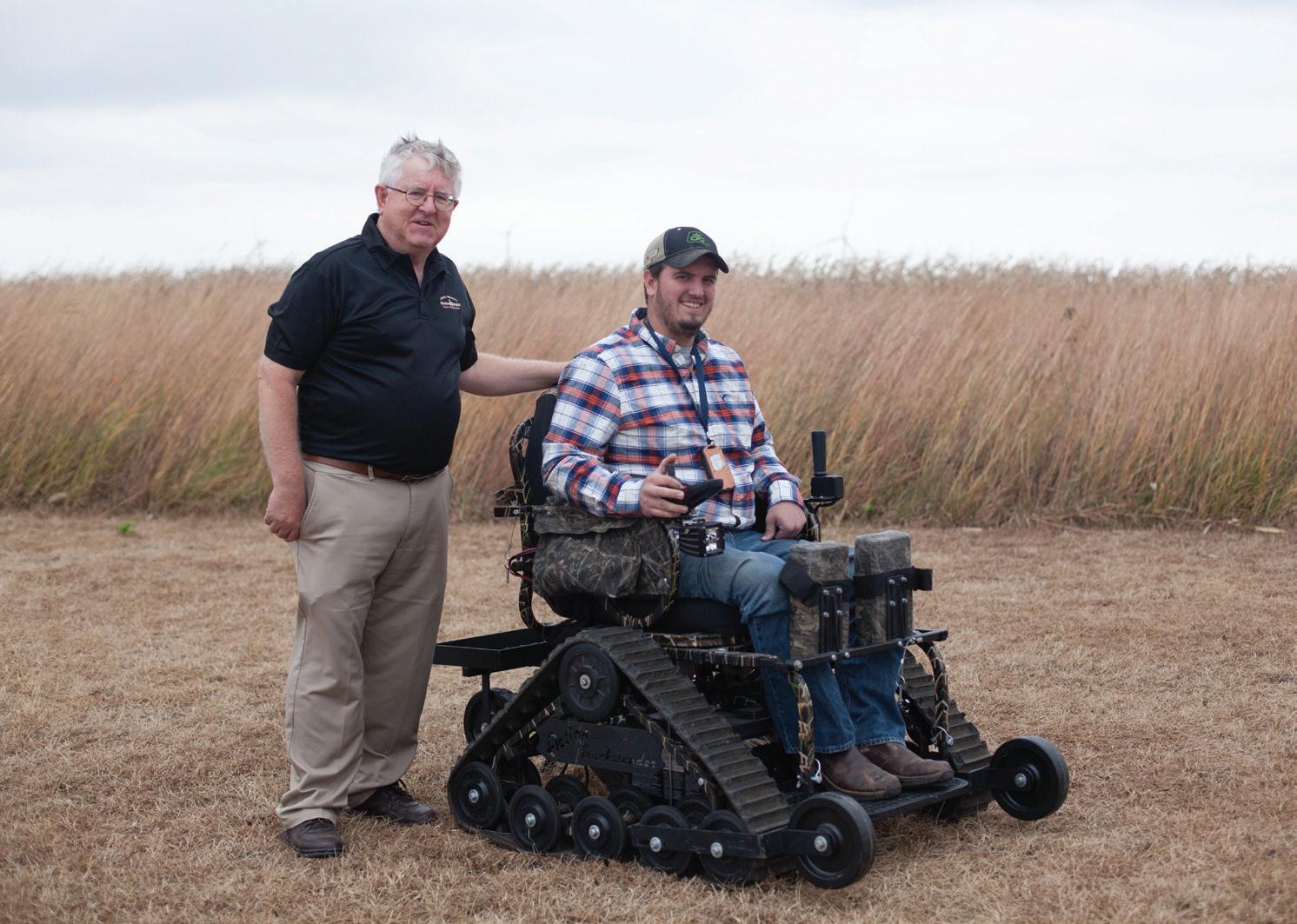
the client’s needs and barriers to completing farm tasks. They often complete assessment reports that can be used for a variety of purposes.”
Jones said AgrAbility helps people in almost any type of agricultural operation with virtually any disability. Traditionally, they focused on physical impairments like arthritis, back problems, amputations, spinal cord injuries, sensory impairments, and many other types of physical disabilities. However, in recent years, partly because of the number of military veterans interested in agriculture, they have expanded services to address farm stress and other mental and behavioral health issues like PTSD.
AgrAbility has been essential to Indiana farmers since 1991, allowing them to continue in an industry they enjoy and regain their independence.
“I’ve met with some of the providers from whom I received specialized equipment, and I can tell it made an impact for them to see a client like me successfully being able to
continue farming and doing what I love,” Hayn said.
Another farmer who’s been helped by AgrAbility, Carl Jenkins, was severely burned in December 1999. With third-degree burns over 70% of his body, Jenkins needed support to continue farming.
“The Lord has helped me keep farming 25 years later with the help of AgrAbility,” said Jenkins.
Ed Bell has been associated with AgrAbility since the beginning of the program. He’s a farmer who is part of the Bell’s Strawberry Farm in Hagerstown. In 1982, Bell and his wife survived a violent attack that left him paralyzed from the collarbone down.
“Probably the biggest thing I've gained from AgrAbility was learning to be independent in my daily personal care,” Bell said. “Prior to the peer support programs sponsored by AgrAbility, I depended on attendant care for my daily needs.”
You can learn more information about AgrAbility at IndianaAgrAbility.org or by calling 800-825-4264.
Chris Adam is a freelance writer from Lafayette.
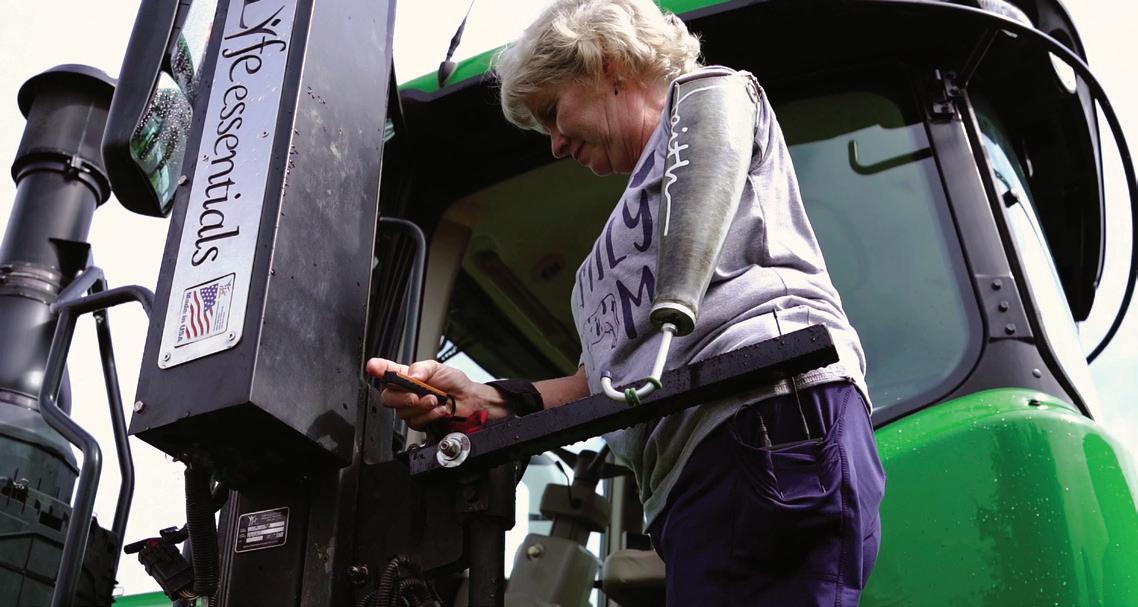

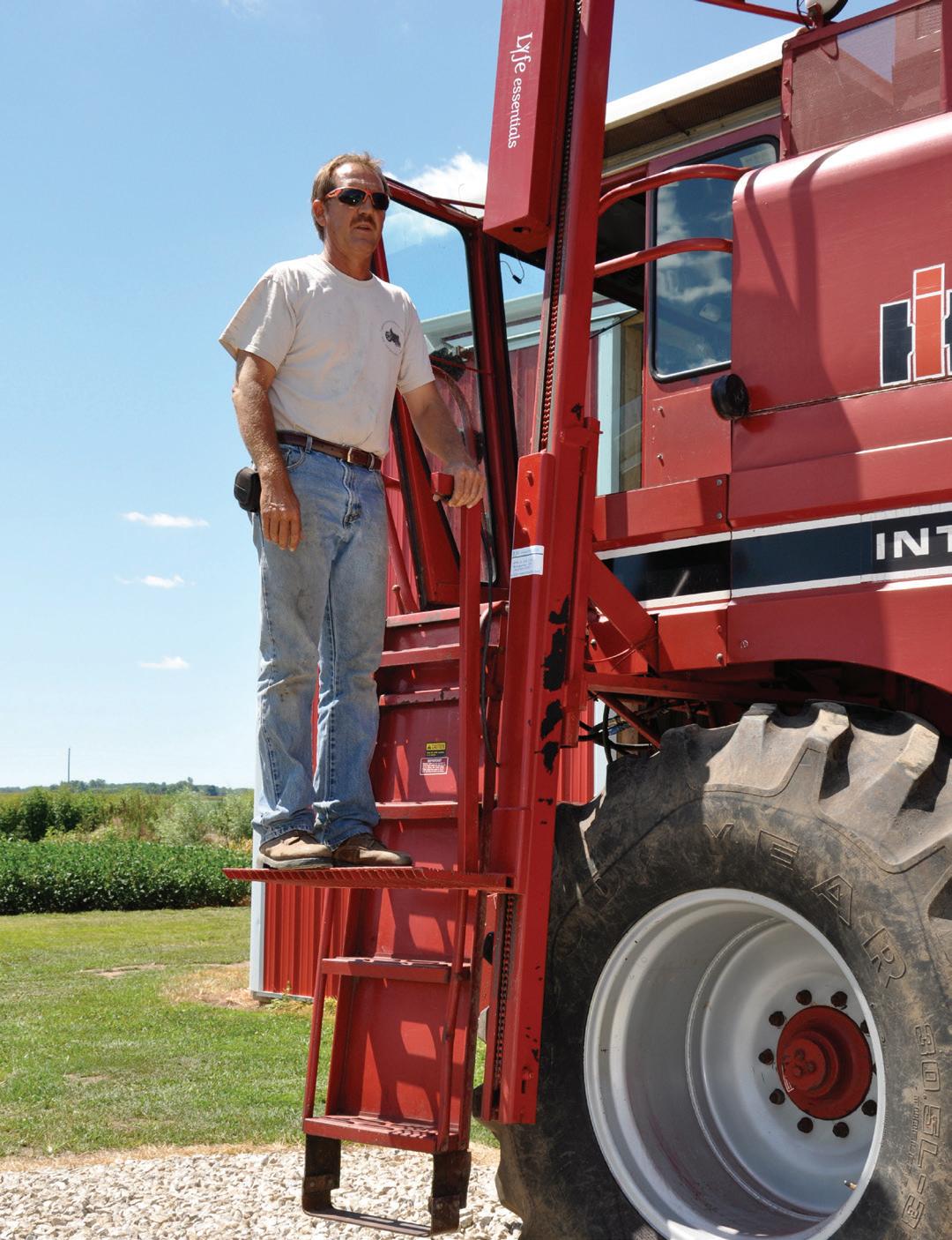




As the demand for electricity continues to rise, Indiana’s two not-for-profit electric generation and transmission (G&T) cooperatives remain focused on providing reliable, affordable energy to their members and the rural and suburban communities they serve. In March, Wabash Valley Power Alliance (WVPA) and Hoosier Energy finalized a joint purchase of St. Joseph Energy Center. The combined cycle natural gas plant in New Carlisle, Indiana, is approximately 15 miles west of South Bend.
“Our job is to keep the lights on for the families and businesses that rely on us,” said Jeff Conrad, president and CEO of Wabash Valley Power Alliance. “As co-ops, our business model allows us to move quickly when the opportunity is right. At a time when
new generation is needed and takes years to build, we could not pass up the opportunity to purchase an existing asset.”
As part of the purchase agreement, WVPA and Hoosier Energy will each take a 50% stake in the facility and share operation and maintenance responsibilities.
“St. Joseph Energy Center is an ideal fit for Hoosier Energy’s Long Range Resource Plan, which prioritizes reliability and resource adequacy, affordability, sustainability, and resource diversity,” said Donna Walker, president and CEO of Hoosier Energy. “The plant has a history of high-level operational performance and will be a dependable asset for our members.”
The 720-megawatt (MW) plant, which began generating power in 2018, sits on a 165-acre campus. The state-of-the-art facility is equipped with two Siemens gas turbines, a steam turbine, and three air-cooled generators. The exhaust heat from the gas turbines is used to power the steam turbine, greatly improving the plant’s overall thermal efficiency.
Economic development activity in Indiana has been robust recently, with several of the world’s largest companies announcing major investments requiring significant amounts of energy. With the addition of St. Joseph Energy Center, WVPA and Hoosier remain well-positioned to serve existing member-consumers while supporting future economic growth.

Over 30 hot air balloons take flight at Angola Balloons Aloft, bringing wonder and fun for all
The sight of a hot air balloon amongst the clouds on a sunny summer day is enough to command one’s attention, but it's the main event for one July weekend in Angola, Indiana. A total of 35 hot air balloon pilots will fly in the Angola Balloons Aloft event, celebrating its 16th year. On July 11 and 12, these pilots will present five specially shaped balloons, including Finley the Fish — sponsored by the Steuben County Tourism Bureau — six corporate balloons, and 24 competitive entries at Angola High School.
“For the first time, a pilot from Japan will be competing,” shared
Janet Hartsuff, Angola Balloons Aloft’s assistant director. “This shows the level of competition is increasing, and we continue to draw an impressive group of pilots from the United States and beyond.”
Five balloon flights are planned over the weekend, but the times will be weather-dependent, with final flight statuses provided on the event’s Facebook page. While flights are finalized, there’s plenty of fun happening on the event’s grounds. Don’t miss the twilight hot air balloon illumination each evening, where 17 balloons line up in front of the school in a breathtaking glow.
“We have paid helicopter rides available both days and a classic car show on Saturday,” said Hartsuff.
“The kids can enjoy the inflatables with paid all-day wristbands, as well as free archery tag. We’ll have local musicians performing throughout the event and 18 food vendors offering items to please kids and adults alike.”
Natalie Derrickson is a writer based in Indianapolis.
Angola Balloons Aloft takes flight July 11 and 12, with a final balloon flight planned for July 13 at 7 a.m., weather permitting. Admission and parking are free. Learn more and plan your trip by visiting angolaballoonsaloft.com.

If a vacation isn’t in the financial plan this year, you can still get that vacation vibe. Check out these ideas to create a backyard oasis you can enjoy all summer.
The light stuff
Lighting is a simple way to start creating your retreat-worthy space. Not only can it be inexpensive, but many options also take little time to install. Try hanging string lights from an overhang, using screw eyes and mini carabiners or reusable, rubber twist ties. You can drape them along a fence or tree for a magical glow.
An economic option is to utilize solar lights. Tuck them into landscaping or add them to planters to add height and brighten up seating areas. Mounted deck lights are a great choice to safely illuminate walking areas. To lean into a tropical theme, add torch stakes along pathways or in garden beds and table torches to brighten an evening dinner.
Have a seat
A relaxing vacation means a comfortable place to rest. To stay budget-friendly, consider investing in one standout piece that is a focal point. This could be a patio table and chairs, an outdoor sofa, or a set of Adirondack chairs to help you feel like you’re staying in your favorite cabin getaway in the mountains.
For a cost-effective strategy, refresh your existing furniture with a deep clean and a new coat of paint. Start by sanding rough areas and cleaning thoroughly. Continue with an exterior primer suitable for the furniture material. Then, finish with either acrylic latex exterior paint or oil-based enamel paint. For metal pieces, consider a primer and paint with a rust inhibitor.
A few aesthetic touches can go a long way in creating a warm and cozy atmosphere. Start with water-resistant accent pillows in your favorite colors or patterns. If you want to kick it up a notch, add a durable and faderesistant rug to define a gathering space and provide comfort for your feet.
Bring life to your deck or patio by adding planters full of your favorite flowers or greenery. Create dimension by utilizing hanging planters. These can easily be attached to overhangs, using screw hooks, s-hooks, and extension chains. Install an arbor or trellis and wrap it with a lush climbing plant or vine for a stunning focal point.
To truly capture that vacation-at-home experience, creating privacy is a must. Use an arbor or trellis to conceal a
small seating area, while adding a touch of charm. Tall shrubs or small trees in planters are another flexible option — easy to move as your needs adjust.
To shield a larger area, hang outdoor curtains between posts or your house exterior. If you don’t want to drill holes, consider using a tension rod or stretching steel cable between trees. Just make sure to choose a lightweight fabric to avoid sagging. All that’s left to do is grab your favorite drink and relax!

Pat Sullivan owns Sullivan Hardware & Garden, offering premium grills, patio furniture, lawn and garden products, and expert service. With multiple locations across central Indiana, including the beloved Allisonville Nursery, it’s a destination for home and garden needs. As a proud Do it Best co-op member, Sullivan combines local service with national buying power. For 70 years, the Sullivan family has delivered quality, value, and a neighborly touch.
This article is for informational purposes only. Indiana Connection and Do it Best assume no liability for the accuracy or completeness of the information contained herein, or for injuries, property damage, or the outcome of any project.
Halfa mile beneath the icy waters off the coast of Argentina lives one of the most remarkable creatures in the world.
Fully grown, they’re less than 2 feet long and weigh under 10 pounds…
But despite their small size, this strange little squid can have a bigger positive impact on your brain health than any other species on the planet.
They are the single richest source of a vital “brain food” that 250 million Americans are starving for, according to a study published in the British Medical Journal.
It’s a safe, natural compound called DHA – one of the building blocks of your brain. It helps children grow their brains significantly bigger during development. And in adults, it protects brain cells from dying as they get older.
Because DHA is so important, lacking enough of it is not only dangerous to your overall health but could be directly related to your brain shrinking with age.
With more than 16 million Americans suffering from ageassociated cognitive impairment, it’s clear to a top US doctor that’s where the problem lies.
Regenerative medicine specialist Dr. Al Sears, says thankfully, “there’s still hope for seniors. Getting more of this vital brain food can make a life changing difference for your mental clarity, focus, and memory.”
Dr. Sears, a highly-acclaimed, board-certified doctor— who has published more than 500 studies and written 4 bestselling books — says we should be able to get enough DHA in our diets… but we don’t anymore.
“For thousands of years, fish were a great natural source of DHA. But due to industrial fish farming practices, the fish we eat and the fish oils you see at the store are no longer as nutrient-dense as they once were,” he explains.
DHA is backed by hundreds of studies for supporting razor sharp focus, extraordinary mental clarity, and a lightning quick memory… especially in seniors.
So, if you’re struggling with
focus, mental clarity, or memory as you get older…
Dr. Sears recommends a different approach.
Research has shown that our paleo ancestors were able to grow bigger and smarter brains by eating foods rich in one ingredient — DHA.
“Our hippocampus thrives off DHA and grows because of it,” explains Dr. Sears. “Without DHA, our brains would shrink, and our memories would quickly fade.”
A groundbreaking study from the University of Alberta confirmed this. Animals given a diet rich in DHA saw a 29% boost in their hippocampus — the part of the brain responsible for learning and memory. As a result, these animals became smarter.
Another study on more than 1,500 seniors found that those whose brains were deficient in DHA had significantly smaller brains — a characteristic of accelerated aging and weakened memory.
Dr. Sears uncovered that sometime during the 1990s, fish farmers stopped giving their animals a natural, DHA-rich diet and began feeding them a diet that was 70% vegetarian.
“It became expensive for farmers to feed fish what they’d eat in the wild,” explains Dr. Sears. “But in order to produce DHA, fish need to eat a natural, marine diet, like the one they’d eat in the wild.”
“Since fish farmers are depriving these animals of their natural diet, DHA is almost nonexistent in the oils they produce.”
“And since more than 80% of fish oil comes from farms, it’s no wonder the country is experiencing a memory crisis. Most people’s brains are shrinking and they don’t even know it.”
So, what can people do to improve their memory and brain function in the most effective way possible?

MEMORY-RESTORING SENSATION: The memory-saving oil in this Antarctic squid restores decades of lost brain power starting in just 24 hours.
Dr. Sears says, “Find a quality DHA supplement that doesn’t come from a farmed source. That will protect your brain cells and the functions they serve well into old age.”
Dr. Sears and his team worked tirelessly for over 2 years developing a unique brain-boosting formula called Omega Rejuvenol. It’s made from the most powerful source of DHA in the ocean, squid and krill — two species that cannot be farmed.
According to Dr. Sears, these are the purest and most potent sources of DHA in the world, because they haven’t been tampered with. “Omega Rejuvenol is sourced from the most sustainable fishery in Antarctica. You won’t find this oil in any stores.”
Already, the formula has sold more than 850,000 bottles. And for a good reason, too. Satisfied customers can’t stop raving about the memory-boosting benefits of quality-sourced DHA oil.
“The first time I took it, I was amazed. The brain fog I struggled with for years was gone within 24 hours. The next day, I woke up with the energy and mental clarity of a new man,” says Owen R.
“I remember what it was like before I started taking Omega Rejuvenol… the lack of focus… the dull moods… the slippery memory… but now my mind is as clear as it’s ever been,” says Estelle H.
“My mood and focus are at an
all-time high. I’ve always had trouble concentrating, and now I think I know why,” raves Bernice J. “The difference that Omega Rejuvenol makes couldn’t be more noticeable.”
And 70-year-old Mark K. says, “My focus and memory are back to age-30 levels.”
These are just a handful of the thousands of reviews Dr. Sears regularly receives thanks to his breakthrough memory formula, Omega Rejuvenol
To secure bottles of this brainbooster, buyers should contact the Sears Health Hotline at 1-888-3588234. “It takes time to manufacture these bottles,” says Dr. Sears. “The Hotline allows us to ship the product directly to customers who need it most.”
Dr. Sears feels so strongly about this product, he is offering a 100%, money-back guarantee on every order. “Send back any used or unused bottles within 90 days and I’ll rush you a refund,” says Dr. Sears.
The Hotline is taking orders for the next 48 hours. After that, the phone number may be shut down to allow for inventory restocking. Call 1-888-358-8234 to secure your limited supply of Omega Rejuvenol. Readers of this publication immediately qualify for a steep discount, but supplies are limited. To take advantage of this great offer use Promo Code ICOM625 when you call.
